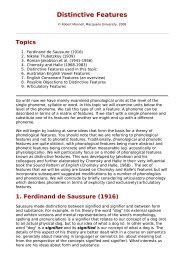The Syllable and the Foot : Summary - Speech Resource Pages
The Syllable and the Foot : Summary - Speech Resource Pages
The Syllable and the Foot : Summary - Speech Resource Pages
You also want an ePaper? Increase the reach of your titles
YUMPU automatically turns print PDFs into web optimized ePapers that Google loves.
If <strong>the</strong>y conform to <strong>the</strong> sonority profile, consonants sequences in<br />
syllable onsets increase in sonority from left to right <strong>and</strong> consonant<br />
sequences in syllable codas decrease in sonority from left to right.<br />
From this we can predict which consonant sequences are more<br />
probable for syllable onsets <strong>and</strong> codas.<br />
probable<br />
/pla fni lju<br />
sma pfle/<br />
/alp ims ort/<br />
less<br />
probable<br />
/lpa nfi jlu<br />
lfpe/<br />
/apl ism<br />
otr/<br />
Why? <strong>The</strong> syllables on <strong>the</strong> right have<br />
two sonority peaks -- <strong>and</strong> so it's much<br />
more difficult to produce <strong>the</strong>m so that<br />
<strong>the</strong>y sound like one syllable…for<br />
example:<br />
So a language is more likely to build monosyllabic words from <strong>the</strong><br />
combination of phonemes on <strong>the</strong> left than on <strong>the</strong> right.<br />
Languages prefer to build syllables from phonemes such that <strong>the</strong><br />
sonority rises from <strong>the</strong> left syllable edge, <strong>the</strong>n reaches a peak (at<br />
<strong>the</strong> vowel), <strong>and</strong> <strong>the</strong>n falls. <strong>The</strong>refore, a language is more likely to<br />
have a syllable like /pla/ than /lpa/, because in /pla/ <strong>the</strong> sonority<br />
rises from its lowest value for /p/, increasing for /l/, <strong>and</strong> reaching a<br />
peak with /a/. Similarly, a language is more likely to have /amp/<br />
than /apm/. We can now see why listeners might hear two syllables<br />
in /ʁpa/ even if a talker intends only one: because <strong>the</strong> sonority is<br />
higher for /ʁ/ (since it is a fricative), <strong>the</strong>n falls for /p/, <strong>the</strong>n rises<br />
again for /a/ (<strong>and</strong> <strong>the</strong> condition to hear one syllable would be that<br />
<strong>the</strong>re is a progressive rise in sonority from <strong>the</strong> syllable's left edge).<br />
It must be recognised that <strong>the</strong>re is only a tendency for syllables to<br />
conform to <strong>the</strong> sonority profile. So while most syllables do conform<br />
to <strong>the</strong> sonority profile in English, many syllables that contain a<br />
consonantal cluster with /s/ do not. An example of a syllable that
















